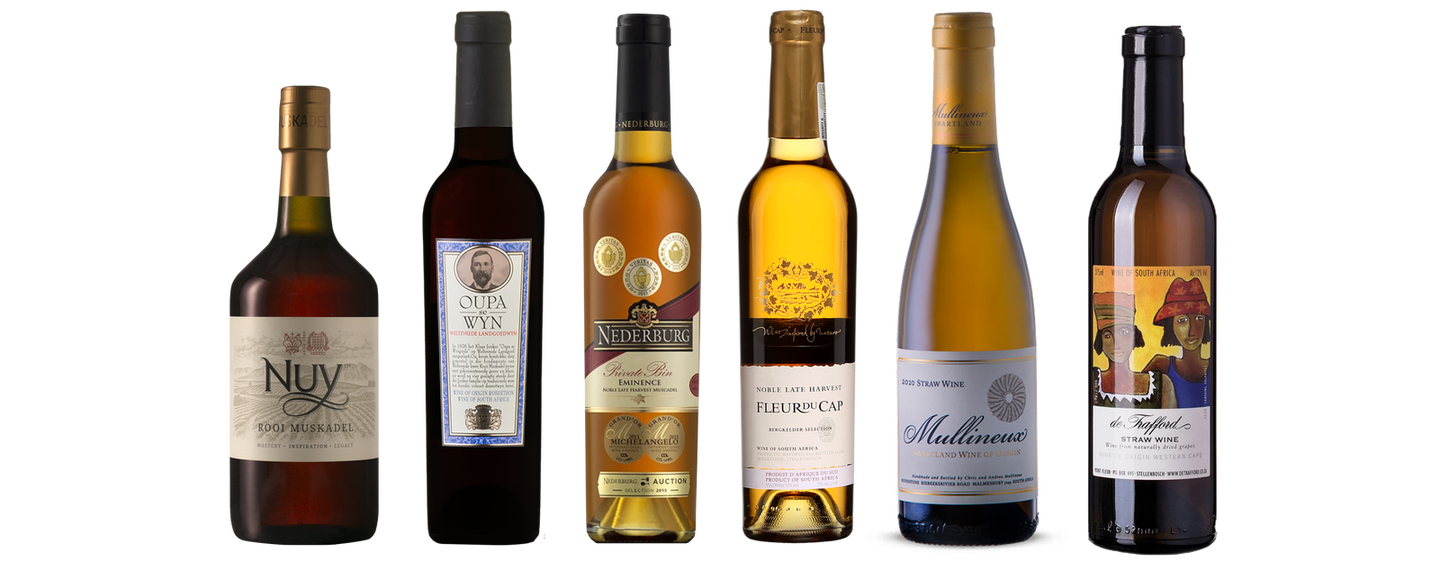
Ambrosia!
Noble late harvest, vin de paille, natural sweet, muscadel and jerepigo. What’s it all about? Fiona McDonald covers the basics of Sweet Wine 101.

Sugar is essential to winemaking. After all, it’s the grape sugar which is converted into alcohol by yeast during the fermentation process. And even in dry wines, like chardonnay or cabernet sauvignon there’s a small amount of residual sugar which remains – but it doesn’t make those wines sweet.
Sweet wines are at the other end of the spectrum and there’s a host of different styles. Some of the world’s greatest wines are sweet, like Hungary’s Tokay or France’s Chateau d’Yquem or even the fabled Vin de Constance. Richly sweet, they enter into the hallowed halls of nectar of the gods or ambrosia ...

There’s 300 years of history in every bottle of Vin de Constance! And the 500ml bottle is modelled on historical handblown examples, slightly asymmetrical, it remains distinctive and instantly recognisable.
The first point of difference is in the measurement of the amount of sugar which remains once the winemaking process is complete – something called residual sugar, handily abbreviated to RS. In terms of South African wine legislation natural sweet wines have a minimum residual sugar level of more than 20g/ℓ. A noble late harvest (NLH) has more than 50g/ℓ and naturally dried grape (straw wine) is more than 30g/ℓ.
As confusing as that may be, all are made differently and that’s what distinguishes them in character and flavour. By way of example, Klein Constantia’s Vin de Constance is a natural sweet wine while the well-known Nederburg Edelkeur, for example, is a noble late harvest. So what’s the difference between them? The grapes for the latter wine have been affected by noble rot – hence the “noble” part of “noble late harvest”.
Noble rot is the layman’s term for Botrytis cinerea, a type of fungus that forms on the ripening bunches when certain conditions like high humidity levels are present. The mould sends a probe through the skin of the grape’s berry and then sucks up the moisture inside, concentrating the sugars in each berry in the process.
What sets NLH or botrytized wines apart is the superb balance of acidity which counters the high sugar levels of the resultant wine. Frequently they have 100 to 150 or even 200g/ℓ of residual sugar. Were it not for the counterbalancing effect of acidity the wines would simply be sticky and almost intolerable.
Natural sweet wines like Vin de Constance however, don’t have any of the noble rot influence. They rely on the grape variety and sheer ripeness for flavour. In some years, the picking teams at Klein Constantia go through the muscat vineyards up to seven times! Their well-trained harvesters know not to pick the entire bunch but to carefully snip out individual golden berries.
And since they rely on the headily aromatic, floral muscat grape for this historic wine once drunk by Napoleon Bonaparte, what’s the difference then between a muscadel and a jerepigo/jerepiko? The trick is in when the spirit is added ...
Both muscadel and jerepigo are fortified wines – which means they have alcoholic spirit (usually grape brandy) added to them. To be a muscadel the wine has to be made from muscat grapes, firstly. For white muscadel generally muscat d’Alexandrie (also known as hanepoot) or muscat blanc à petit grains are used while red muscadel is from muscat de frontignan.

Nuy rooi muscadel and Weltevrede’s Oupa se Wyn are prime examples of South African muscadel while both Nederburg and Fleur du Cap noble late harvest boast medals galore. Mullineux and De Trafford straw wines are both made with chenin blanc grapes.
The process is standard: producers begin making a normal wine but then stop the fermentation halfway by adding grape spirit. The spirit halts the fermentation yeast in its tracks, preventing it from converting sugar to alcohol. This retains the sweet fruitiness of the wine but raises the alcohol level to between 15 and 22% by volume.
By contrast, jerepigo never undergoes any fermentation. It’s simply grape juice to which spirit – generally brandy spirit – is added.
And straw wine, also known as vin de paille? That’s when (non-muscat!) grapes are picked late, when ripe and sweet (again, with no botrytis influence) and then laid out on straw mats to shrivel and dry in the sun. This semi-raisining also concentrates the sugars before the grapes are turned into wine.
Did you know?
In the 1990s muscat was the sixth most planted grape in South African soil, comfortably outstripping cabernet sauvignon. That’s no longer the case with muscat now making up less than 2% of the national vineyard.
BACK TO TOP